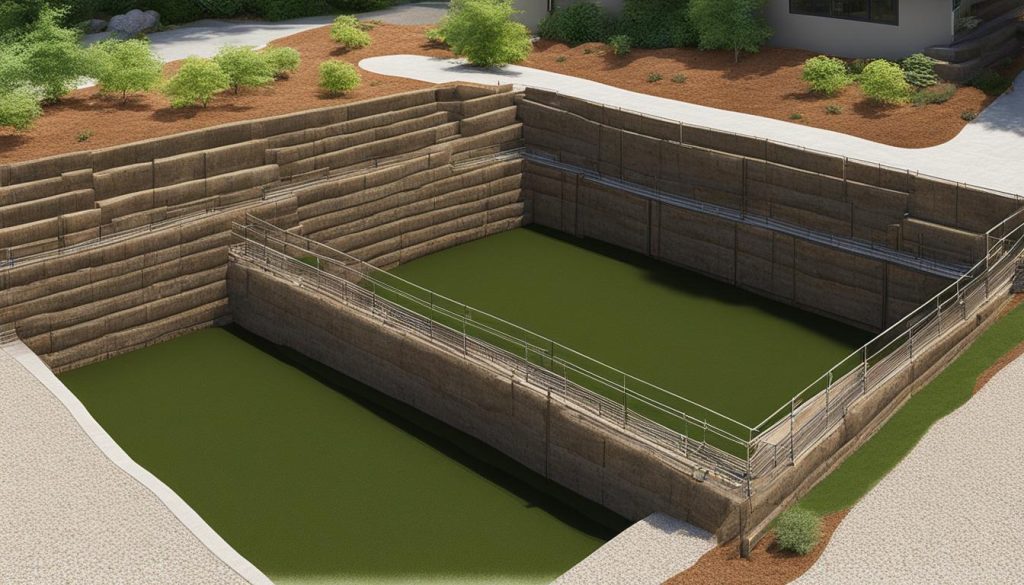Welcome to our comprehensive guide on retaining wall foundations. Whether you’re planning to build a retaining wall in your backyard or on a larger scale, understanding the foundational elements is crucial for creating a stable and long-lasting structure in your Canadian space. In this section, we will explore the key considerations to keep in mind when it comes to retaining wall foundations in Canada.
Key Takeaways
- Retaining wall foundations are essential for creating a stable and long-lasting structure.
- Understanding the factors that influence foundation design is crucial for determining the appropriate design for your project.
- Choosing the right material for your retaining wall foundation is vital for its structural integrity.
- Proper preparation, excavation, and construction techniques are essential for creating a stable foundation.
- Regular maintenance and timely repairs are necessary for preserving the functionality and appearance of your retaining wall foundation.
Understanding Retaining Walls and Their Importance
Before we get into the nitty-gritty of retaining wall foundations, it’s important to understand the role of retaining walls and why they’re essential.
Retaining walls serve two primary functions:
- Preventing soil erosion
- Providing support for sloped landscapes
Without retaining walls, soil erosion can cause significant damage to your property and neighboring areas. Additionally, sloped landscapes can be challenging to navigate and can limit outdoor living space. Retaining walls offer a solution for both of these issues, creating aesthetically pleasing and functional outdoor spaces while also preventing erosion.
There are several types of retaining walls, each with its own benefits and limitations. Here are some of the most common:
| Type | Description |
|---|---|
| Gravity Walls | Constructed from heavy materials, such as stone or concrete. These walls rely on their weight to provide stability. |
| Cantilever Walls | Designed with a horizontal base and a vertical stem. These walls use leverage to support the weight of the soil behind them. |
| Piled Walls | Constructed by driving steel or concrete piles into the ground and then anchoring them into a retaining wall. |
| Anchored Walls | Similar to piled walls, but these walls use cables or rods to anchor the wall to the soil behind it. |
Choosing the right type of retaining wall depends on several factors, such as the height and angle of the slope, soil type, and the budget. Consulting with a professional retaining wall contractor can help determine the most suitable option for your project.
Now that we’ve covered the basics of retaining walls, let’s dive into the crucial factors that influence the design of retaining wall foundations.
Factors Influencing Retaining Wall Foundation Design
When designing a retaining wall foundation, several factors must be considered to create a structurally sound and long-lasting structure. The following are some key factors that influence foundation design:
Soil Conditions
The type and quality of soil on your site can significantly impact the design of your retaining wall foundation. Different soil types have varying load-bearing capacities and drainage characteristics, which affect the stability and durability of your retaining wall foundation. It is essential to conduct a soil test to determine the soil’s suitability and choose the appropriate design and materials accordingly.
Site Topography
The topography of your site can directly affect the design of your retaining wall foundation. If your site has a sloped or uneven terrain, the retaining wall foundation must be designed to withstand the additional lateral forces created by the sloping ground. Additionally, the location of underground utilities, rocks, and other obstructions can impact the foundation’s placement and design.
Hydrostatic Pressure
Hydrostatic pressure is the force exerted by groundwater against the retaining wall. The pressure can build up behind the wall, leading to instability or failure if not addressed properly. The design of the retaining wall foundation should consider the water table level and incorporate adequate drainage systems to relieve the hydrostatic pressure.
Retaining Wall Height
The height of your retaining wall is a crucial factor in determining the design of the foundation. Higher walls require thicker and more robust foundations to withstand the additional vertical and lateral forces. The foundation design should also consider the angle of repose, which is the maximum slope angle the soil can maintain without collapsing.
By taking into account these critical factors, we can create a retaining wall foundation design that adequately addresses the unique needs of your site. At Retaining Wall Repair, we have extensive experience in designing and constructing retaining wall foundations that meet the most stringent quality and safety standards. Our team of experts is ready to provide you with customized solutions that ensure the longevity and functionality of your retaining wall foundation. Contact us today to learn more about our expertise and services!
Types of Retaining Wall Foundations
Retaining walls come in different shapes and sizes, and so do their foundations. In this section, we will explore the various types of retaining wall foundations to help you choose the most suitable one for your project.
Gravity Walls
Gravity walls rely on their size and weight to hold back soil. They are typically made of concrete, stone, or brick, and are best suited for low retaining walls with a height of up to 4 feet. These types of walls require a wide footing, which distributes the weight of the wall over a broad area, making them more stable.
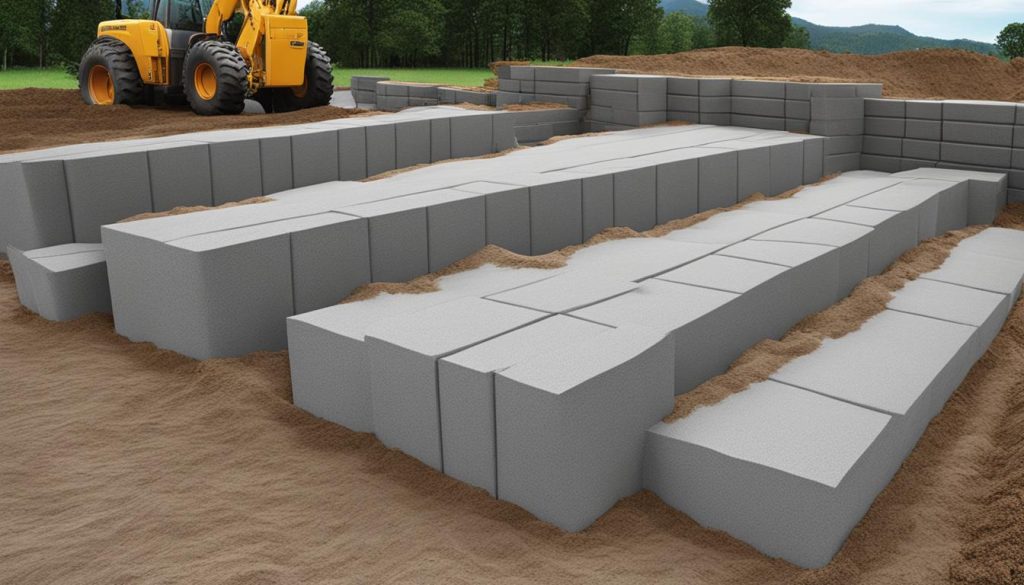
Cantilever Walls
Cantilever walls are made of reinforced concrete and are appealing for their strength and flexibility. They use a base slab and a thinner stem to support the weight of the soil. They are ideal for walls with heights of up to 25 feet and require less materials than gravity walls.
Piled Walls
Piled walls are built using steel or concrete piles that are driven into the soil and then filled with concrete. They are suitable for walls with heights of up to 60 feet and are ideal for areas with limited space, where a wide footing is not feasible. Piled walls are commonly used for waterfront retaining walls that need to withstand strong wave loads.
Anchored Walls
Anchored walls are a type of retaining wall that uses cables or rods to anchor the wall to the soil behind it. This design helps to distribute the load of the soil over a larger area, providing more stability for the wall. Anchored walls are ideal for walls with heights greater than 25 feet and are popular in highway construction projects or steep soil retention.
Each type of retaining wall foundation has its pros and cons, and choosing the right one depends on several factors. We recommend consulting with a professional to determine which foundation design best suits your project.
Choosing the Right Material for Retaining Wall Foundations
When it comes to choosing the right material for your retaining wall foundation, you want to consider several factors to ensure structural stability and longevity. We’ve compiled a list of popular materials used in Canada for retaining wall foundations, along with their pros and cons to help you make an informed decision for your project.
Concrete
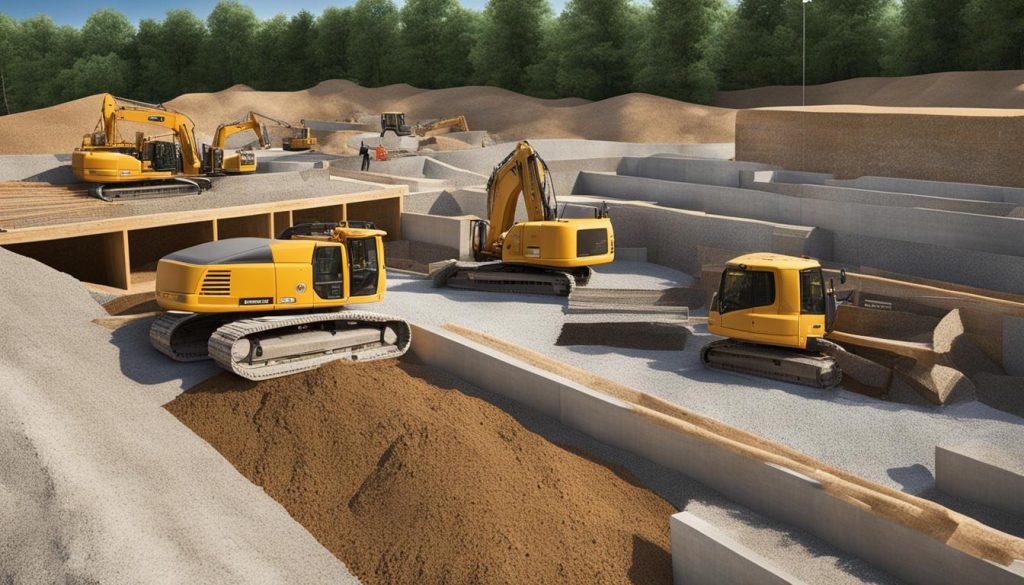
Concrete is one of the most popular materials for retaining wall foundations due to its durability and strength. It’s also versatile and can be formed into different shapes and sizes, providing a range of design options. However, concrete can be more expensive than other materials, and its heavy weight may require additional support during construction.
Timber
Timber is another popular choice for retaining wall foundations. It’s lightweight, easy to install, and offers a natural look that fits well with outdoor environments. However, timber is susceptible to rot, insect damage, and warping over time, which can compromise the integrity of the structure. Additionally, timber walls may need to be replaced more frequently than other materials, which can increase long-term costs.
Stone
Stone is a classic material used for retaining wall foundations due to its durability and aesthetic appeal. It’s also resistant to water damage and erosion, making it an excellent option for areas with high levels of rainfall or water runoff. However, stone can be more expensive than other materials, and its weight may require additional support during construction. Additionally, the irregular shape of stones can make installation more challenging and time-consuming.
Ultimately, the choice of material for your retaining wall foundation will depend on your specific project requirements, budget, and design preferences. At Retaining Wall Repair, we can help you select the most suitable material for your unique needs and provide professional installation services to ensure a structurally sound retaining wall foundation.
Preparation and Excavation for Retaining Wall Foundations
Proper preparation and excavation are crucial to creating a stable foundation for your retaining wall. The first step in the process is to clear the site and remove any debris or obstructions that may interfere with the excavating machinery.
The next step is to map out the site’s perimeter to ensure the retaining wall meets the desired specifications. At Retaining Wall Repair, we use state-of-the-art equipment to conduct soil tests and soil analysis to ensure we understand the soil composition in your specific area. Soil analysis helps us determine the appropriate excavation depth, ensuring that your retaining wall’s foundation has the necessary support to withstand external forces.
Our team of experts will then excavate the site to the required depth and contour the area to create space for the foundation. It’s essential to take weather conditions into account during this phase, as excavation may become complicated during the rainy season when soil is wet. At Retaining Wall Repair, we take all necessary precautions to ensure the job is done right the first time.
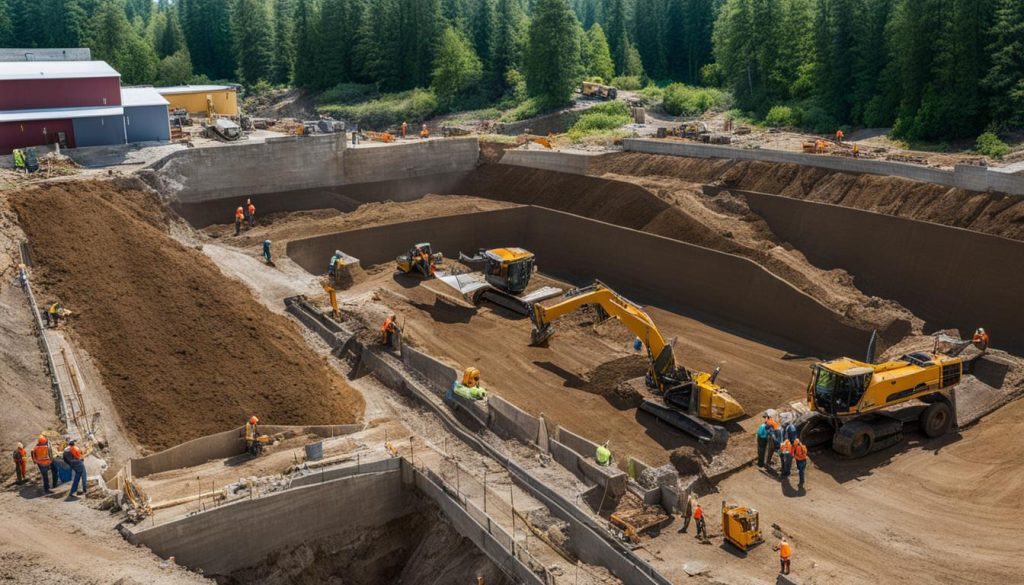
Once the excavation process is complete, we use specialized equipment to compact the soil and ensure that your retaining wall foundation has a firm base to withstand the weight of the structure. Adequate compaction of the soil is essential as it improves the foundation’s load-bearing capabilities, reduces the likelihood of settling, and increases the overall stability of the retaining wall.
At Retaining Wall Repair, we recommend consulting with our experts to ensure that your retaining wall foundations are adequately prepared and excavated. Our team has the experience and technical expertise to ensure that your retaining wall foundation has a solid foundation and is long-lasting.
Construction Techniques for Retaining Wall Foundations
Constructing a retaining wall foundation demands specific techniques to ensure its stability and longevity. At Retaining Wall Repair, we have years of experience in building and repairing retaining walls, and we are happy to share our expertise with you. Below are some of the essential construction techniques that you should consider for your retaining wall foundation.
Reinforcement Placement
Reinforcement is an integral component of retaining wall foundations and should be placed correctly to ensure its effectiveness. The reinforcement placement depends on the type of wall and the height of the wall. Generally, reinforcement should be installed at one-third of the wall’s height and should include steel bars or mesh. Proper placement ensures that it can withstand the lateral pressure exerted by the soil and water.
Proper Drainage Installation
Drainage is another critical aspect of retaining wall construction. Poor drainage can cause hydrostatic pressure that can damage the foundation and compromise the wall’s stability. Proper drainage installation includes the use of drainage tiles or pipes and gravel. The drainage structure should be located behind the retaining wall to ensure water flows freely towards the drainage system. This method will help reduce the hydrostatic pressure and prevent water from collecting behind the wall, which can cause damage.
Backfilling Procedures
Backfilling refers to the process of replacing the soil behind the retaining wall. The backfilling must be done correctly to provide the necessary support and stability for the wall. The soil should be compacted in layers to prevent voids and gaps that can later cause displacement. A proper backfilling procedure involves using suitable equipment and a compaction technique suitable for the type of soil used.
Compaction Methods
Compaction is the process of using controlled force to compress soil to remove air gaps and improve the soil’s load-bearing capacity. Compaction ensures that the soil is dense and can support the wall structure. The compaction technique used depends on the soil type and the size of the project. Common compaction methods include vibratory plates, rollers, and ramming.
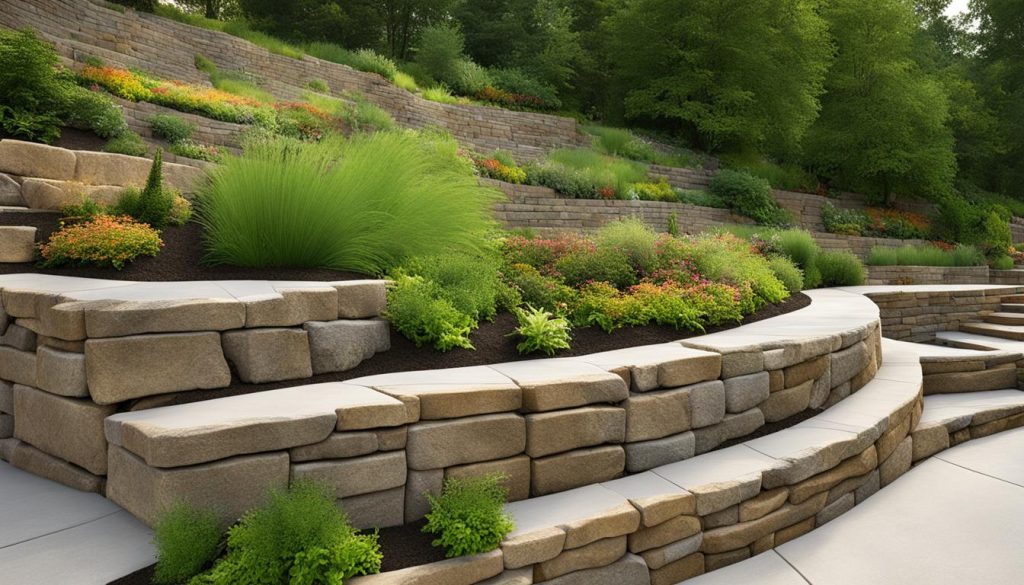
At Retaining Wall Repair, we understand that building a stable and durable retaining wall foundation requires professional expertise and the right equipment. We are committed to offering you top-notch construction techniques for your retaining wall foundation.
Maintaining and Repairing Retaining Wall Foundations
Regular maintenance and timely repairs are essential for preserving the beauty and functionality of your retaining wall foundation. Neglected retaining walls can lead to severe damages, risking safety hazards and costly renovations. Therefore, we recommend incorporating routine maintenance practices to avoid such issues.
Here are some essential maintenance practices to keep your retaining wall foundation in optimal condition:
- Inspect the retaining wall foundation regularly to identify any signs of damage, such as cracks, bulges, or leaning walls.
- Clear debris, such as leaves, grass, and dirt, from the retaining wall foundation and surrounding areas.
- Remove any vegetation or trees that may cause damage to the retaining wall foundation or create excessive moisture.
- Ensure proper drainage systems to prevent water accumulation and soil saturation that can compromise the structural integrity of the retaining wall foundation.
- Address any repairs promptly before the damage escalates. Delaying repairs may lead to more extensive foundation damage, resulting in increased costs and safety hazards.
If you notice any foundation issues, such as cracks, bowing walls, tilted retaining walls, or water damage, contact Retaining Wall Repair immediately. Our team of experts will conduct a thorough inspection and provide you with a comprehensive assessment and repair plan tailored to your needs.
Some signs that indicate the need for professional repairs include:
- Cracks in the foundation or walls
- Bowing or tilting walls
- Bulging retaining walls
- Water damage or stains
- Signs of soil erosion
At Retaining Wall Repair, we offer various services that address all your retaining wall foundation needs. We provide services such as foundation crack repair, bowing or leaning wall repair, and water damage restoration.
Here are some benefits of choosing Retaining Wall Repair for your foundation needs:
- Experienced and skilled professionals
- High-quality workmanship
- Use of top-rated materials and equipment
- Efficient and timely services
- Competitive pricing
Contact us today at (647) 812-9837 or visit our website to schedule your appointment or request a free quote. Trust us to provide you with exceptional services and leave your retaining wall foundation in excellent condition!
Contact Information
Thank you for taking the time to read our comprehensive guide on retaining wall foundations. We hope this information has been informative and helpful in your project planning. Remember, proper foundation design and construction are crucial for a long-lasting and stable retaining wall.
If you have any further questions or require professional assistance, do not hesitate to contact us at Retaining Wall Repair. Our team of experts is ready to provide you with top-notch solutions tailored to your specific needs.
FAQ
What is a retaining wall?
A retaining wall is a structure designed to hold back soil or other materials and prevent erosion or the collapse of slopes. It is typically used to create level areas, prevent landslides, or protect structures.
Why are retaining walls important?
Retaining walls are important because they provide stability, prevent soil erosion, and protect against property damage. They also enhance the aesthetic appeal of landscapes and can create usable spaces in areas with uneven terrain.
What factors influence the design of retaining wall foundations?
Several factors influence the design of retaining wall foundations, including soil conditions, site topography, hydrostatic pressure, and the height of the retaining wall. These factors determine the type and size of the foundation required for stability.
What are the different types of retaining wall foundations?
The different types of retaining wall foundations include gravity walls, cantilever walls, piled walls, and anchored walls. Each type has its unique characteristics and benefits, depending on the specific project requirements.
How do I choose the right material for my retaining wall foundation?
When choosing the material for your retaining wall foundation, consider factors such as durability, aesthetics, cost, and maintenance requirements. Common materials used include concrete, timber, and stone, each with its advantages and drawbacks.
What preparation and excavation steps are necessary for retaining wall foundations?
Proper preparation and excavation are crucial for a solid retaining wall foundation. This includes site preparation, soil testing, and excavation techniques to ensure stable ground conditions and proper drainage.
What construction techniques are important for retaining wall foundations?
Construction techniques for retaining wall foundations include proper reinforcement placement, installation of drainage systems, appropriate backfilling procedures, and compaction methods. These techniques ensure the stability and longevity of the retaining wall.
How do I maintain and repair retaining wall foundations?
Regular maintenance, such as inspecting for signs of damage or erosion and addressing them promptly, is essential for retaining wall foundations. If repairs are needed, it is recommended to seek professional assistance to ensure proper restoration and prevent further issues.
How can I contact Retaining Wall Repair for assistance?
To reach Retaining Wall Repair for professional assistance or further questions, you can contact us at (647) 812-9837 or visit our website at https://www.retainingwallrepair.ca/. Our team of experts is ready to provide tailored solutions for your retaining wall needs.

